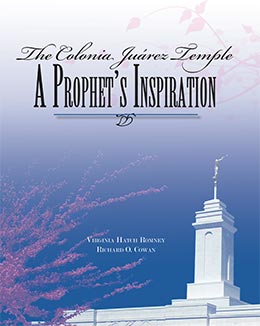A Site for the Temple
Virginia Hatch Romney and Richard O. Cowan, The Colonia Juárez Temple: A Prophet’s Inspiration (Provo, UT: Religious Studies Center, Brigham Young University, 2009), 31-41.
After President Gordon B. Hinckley made his epic announcement of plans to build the three small temples, Church leaders were eager to move forward with their construction. Even though they wanted to push the Monticello temple to completion first, they also gave prompt attention to the temple in the Mexican colonies. The first step was to select the specific site to build on.
Site Selection
President Hinckley had announced a temple would be built “in the Mormon colonies in northern Mexico” but did not specify exactly where it would be located.[1] A reporter from El Diario, the local Spanish newspaper, visited with three Church members at the Dublán chapel. Even though they didn’t know whether the temple would be in Colonia Dublán or Colonia Juárez, it was for them “a source of great rejoicing just knowing that we will have a temple in our region.”[2] Naturally, however, residents in each colony hoped the temple would be located in their own community.
Even before the public announcement of the three small temples, President Hinckley was thinking about the site for the temple in the colonies. In his meeting with Elders Jerald Taylor and Eran Call the day before, he discussed possible locations. The President asked them if members in the colonies would likely be willing and able to donate a site. They assured him that this would be the case. They specifically talked about the property owned by the D. S. Brown family between the stake center and the academy. Elder Taylor also said that “the Romneys had some land on the hill [above the Juárez Academy] where a temple could easily be seen.”[3]
President Hinckley’s priesthood session announcement explained that “where possible, we would place [a small temple] on the same grounds as the stake center, using the same parking lot for both facilities, thereby effecting a great savings.”[4] Therefore the Church Real Estate Department specified that the site preferably should be adjacent to an existing or future facility (stake center or ward chapel) to reduce cost and simplify maintenance; however, it could also be a free-standing site.
Rodmar Pulley, an attorney and manager of government and external relations for the Church worldwide, was involved in the analysis of sites, permits, and approvals. He, along with others, was in charge of narrowing down the list of potential sites in the colonies. He reported that President Meredith I. Romney of the Colonia Juárez Stake and President Carl L. Call of the Colonia Dublán Stake were especially helpful during this process.
Brother Pulley explained that “there were several concerns and drawbacks in building the temple in Colonia Juárez,” one of these being “the lack of fire services.” The first three small temples were “a pilot project,” and the one in the colonies was the first to be built outside the United States.[5] Some regarded Colonia Dublán as a more practical choice because hotels, restaurants, and transportation were readily available in adjacent Nuevo Casas Grandes.
A few weeks after the announcement in general conference, Allen Erekson of the Temple Department called the two stake presidents. He informed them that he, together with men from the Temporal Affairs Office in Mexico City, would like to meet with them and inspect all properties that might be suitable as a temple site.
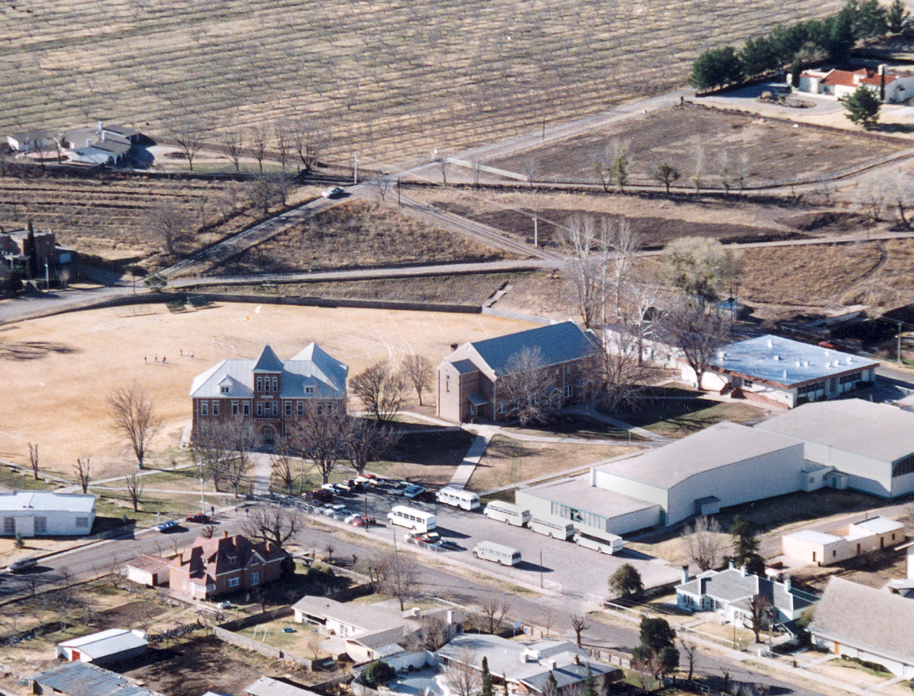 Academia Juárez and the temple site above. Courtesy of Marvin Longhurst.
Academia Juárez and the temple site above. Courtesy of Marvin Longhurst.
“We looked at three approved places in Dublán and four in Colonia Juárez,” recalled President Romney. “We were on the east side of the academy looking at a possible location when Brother Erekson looked up at the hillside and asked to whom that property belonged.” President Romney answered that it belonged to him and his father’s family. Brother Erekson asked if that property might be available. Brother Romney assured him that it would be if that was the site the Church wanted. He didn’t want people to think that he, as stake president, had promoted the property of which he was part owner.
Allen Erekson took all this information to Salt Lake City and showed it to President Hinckley. There was extensive discussion on whether to build the temple in Colonia Juárez or in Colonia Dublán. Meredith Romney recalled, “President Call and I were each asked to recommend a site, and we narrowed it down to the two most likely locations, one in Colonia Dublán and one in Colonia Juárez. We left it up to President Hinckley to make the final decision.”[6]
About this time, while President Carl Call was visiting relatives in Utah and doing some family history research, President Hinckley invited him into his office and had him look at the video that had been made of the available sites. He then asked him what he thought about the sites that had been proposed. President Call replied, “If you are asking Carl Call, I think Dublán, but if you are asking President Call, I think Colonia Juárez.”
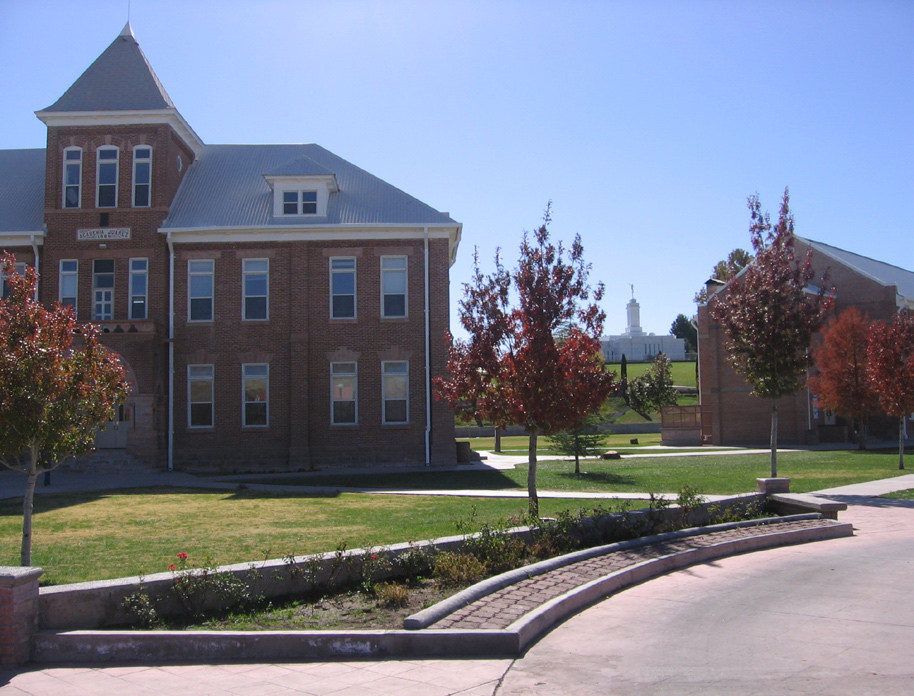 The temple, easily seen from the Juárez Academy campus. Courtesy of Scott C. Esplin.
The temple, easily seen from the Juárez Academy campus. Courtesy of Scott C. Esplin.
President Meredith Romney continues his account, “A few days after his conversation with President Call, President Hinckley called me again and said he was having quite a dilemma as to where the temple should be built, not wanting to offend either community. He asked for my opinion, and I mentioned that I thought it would be a positive influence in the lives of the youth of both stakes if they could look out the classroom windows of the academy and see the temple. President Hinckley then said, ‘My mind tells me that it should be in Colonia Dublán because of the practicality of it, but my heart tells me it should be in Colonia Juárez.’”[7]
Brother Pulley explained all that was involved during this process: “President Hinckley looked at a lot of photographs and spent three days analyzing each site. The First Presidency made the final decision and then gave the recommendation to the Temple Construction Department.”[8] Thus, only after much deliberation was the decision finally made to build the temple in Colonia Juárez.
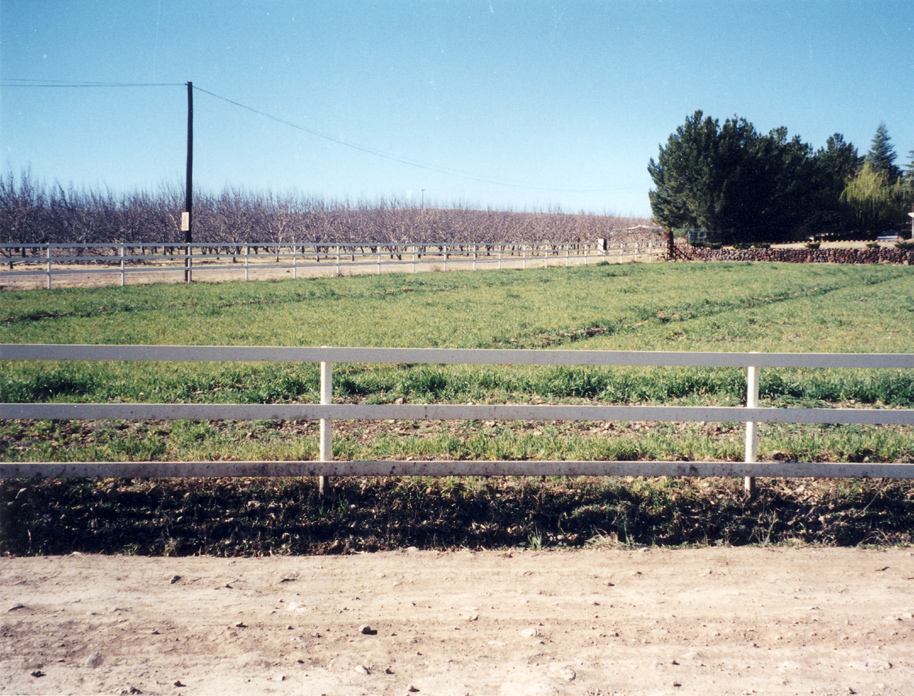
Victor M. Cerda, a leader in Colonia Dublán, said that upon hearing the site announcement, members’ reactions varied. Many felt that the matter was in the hands of the Lord through His prophet and that it would be built where He wanted it to be built. They stated that the presence of the temple was more important than the location. Others had strong arguments of why the temple should have been located in Colonia Dublán or in Nuevo Casas Grandes. When the announcement was made, some felt initial discomfort, even anger. However, with time and knowing the reasons for the decision, the general consensus was that the temple site was in the right place.[9]
Land Donors
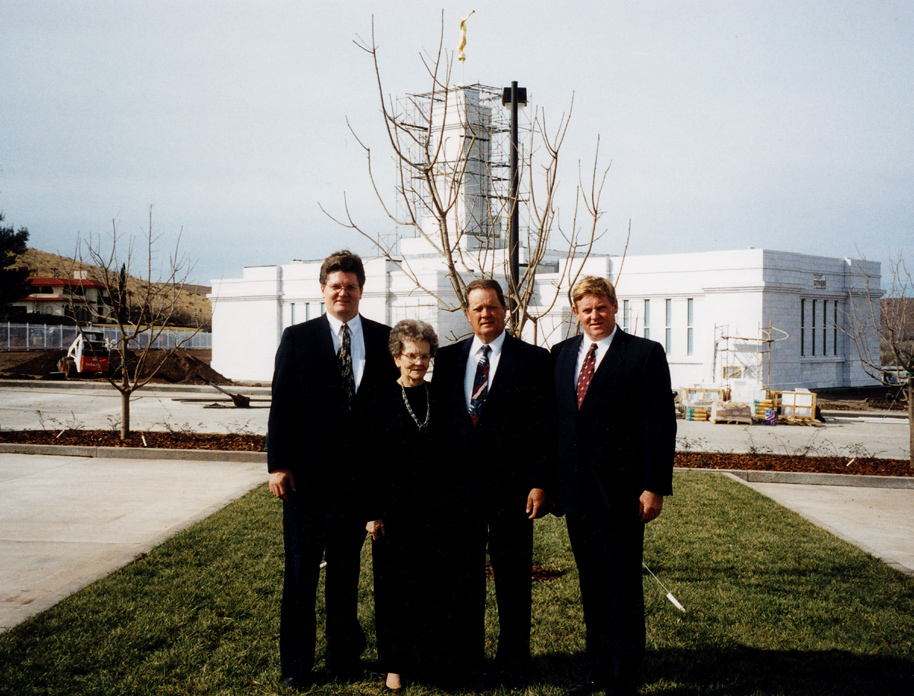 The Romney family (left to right, Leighton, Nellie, Meredith, and Kelly) on the land they donated, as the temple nears completion.
The Romney family (left to right, Leighton, Nellie, Meredith, and Kelly) on the land they donated, as the temple nears completion.
As area residents in both colonies were approached about the possibility of donating land for the temple, everyone was anxious and more than willing to cooperate. The Irvin B. Romney family was no exception. The owners of the chosen temple site were his widow, Nellie S. Romney, and her three sons, Meredith, Kelly, and Leighton. The land was on the west hillside that overlooked the Juárez Academy campus. It was a beautiful and perfect location for the temple because it could be seen for miles around.
The Romneys donated approximately 3.5 acres of property to the Church. It took only about thirty days to get all the deeds legalized and turned over to the Church. In Mexico, changing a name on a title often took months and possibly even years. However, the presidente municipal of Casas Grandes was helpful in expediting the transition without the usual delays.
Groundbreaking Ceremony
Elder Eran A. Call of the Seventy was appointed in October 1997 to become president of the Mexico North Area, replacing Elder Andrew W. Peterson, who had been seriously injured in a motorcycle accident. President Call’s counselors were Elder Dale E. Miller, who, like Elder Call, had become a member of the Second Quorum of the Seventy in April, and Elder Tomás Valdez, an Area Seventy.
On Friday, February 27, 1998, at about 5 p.m., President Call received an unexpected telephone call at his office in Monterrey. F. Michael Watson, secretary to the First Presidency, indicated that President Hinckley wanted to speak with Elder Call but asked him to wait in his office because the prophet was at that moment en route back from Rexburg, Idaho, where he had just installed David A. Bednar as president of Ricks College. Elder Call continues the account:
President Hinckley called back and said, “Elder Call, when do you have time in your schedule to preside over the groundbreaking ceremony for the Colonia Juárez Temple?”
I said, “I have a free weekend next week before meeting you in Hermosillo for your tour of the north area of Mexico.” He said that would be fine.
I said, “Will someone be giving me instructions on what we should do?”
He said, “They are your people. You know them. Just go do it.” I immediately called President Meredith Romney, President Carl Call, and Brother Maurice Bowman [of the Dublán First Ward]. I asked Brother Bowman if he could get a choir ready, and he said, “We are already practicing.”[10]
President Call also consulted with his counselor, Elder Miller, who had participated in the groundbreaking for the Santo Domingo Dominican Republic Temple and was already in the colonies to preside at the conference of the Colonia Juárez stake.
March 7, 1998, was an unforgettable day.[11] Feelings of those present were aptly stated by Andrew Larsen, a missionary serving in the Chihuahua mission: “[The colonies are] an area rich in pioneer history, and I feel proud for my ancestral tie there. From what I have read in my family history accounts and from personal experience, I know that those on the other side of the veil are aware of special events here and are often granted the opportunity to be present. I feel that my faithful forefathers will probably be present today as a holy temple to the Lord begins construction in the land they loved so much.”[12]
It was an unpredictable March day. Members started for the temple site bundled in heavy coats, gloves, and, for those carrying small children, blankets to keep warm from the bitterly cold winds and light snow. On this stormy morning, President Call and his wife Kay knelt and prayed before leaving their bedroom in President Romney’s home. Kay recalled that her husband “thanked Heavenly Father for the great blessing of having a temple built in his homeland.” He also petitioned the Lord to “temper the elements” at the temple groundbreaking services. Fifty-five years earlier, Elder Call’s patriarchal blessing had promised, “Eran, your name shall be known among the records of the Church, and you shall have the power to control the elements, even as you develop faith in the Lord.”[13]
The weather deterred few, if any, eager members from the occasion, however. Over eight hundred were in attendance from Colonia Juárez, Dublán, Nuevo Casas Grandes, Chihuahua City, Ciudad Juárez, Ciudad Delicias, and even Utah. One visitor commented that had this ceremony been held in her home state, under similar weather conditions, the number in attendance would have been dramatically reduced.
As the storm unleashed its fury, John Whetten, the academy’s principal and a member of the Juarez First Ward, invited Elder Call to move the services into the school auditorium. Elder Call, however, replied that “the temple is to be built on this site, and we will have the dedication here under the skies.”[14]
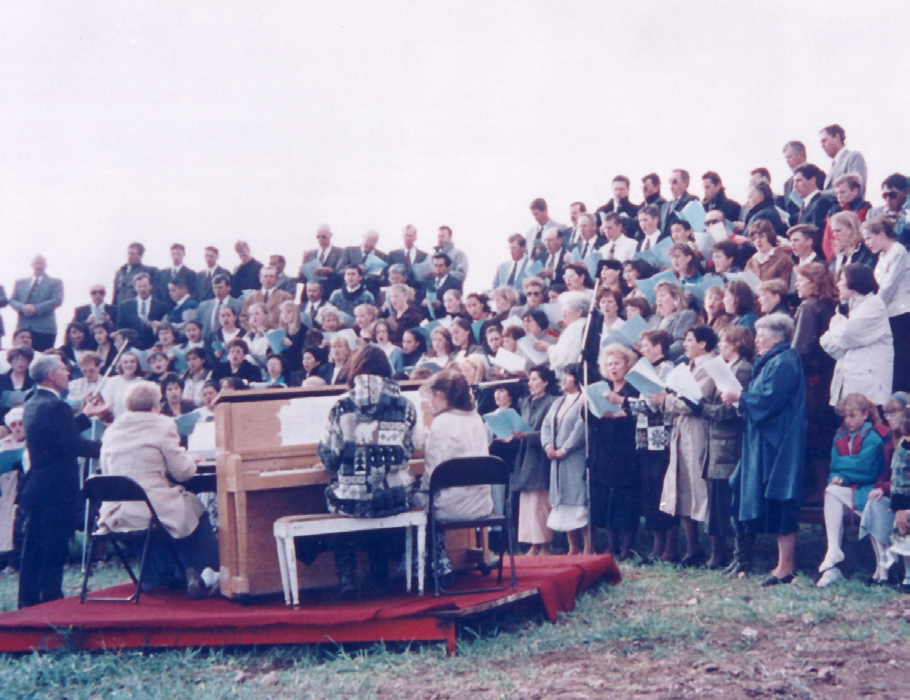 Bistake choir under the direction of Maurice Bowman with organist Julie Taylor and pianist Chris Jones.
Bistake choir under the direction of Maurice Bowman with organist Julie Taylor and pianist Chris Jones.
The combined stake choir sounded beautiful, even though it was seated in high bleachers that provided little protection from the chilly winds. Under the direction of Maurice Bowman and accompanied by pianist Chris Jones and organist Julie Taylor (both of Dublán First Ward), they sang “Una Obra Maravillosa” (A Marvelous Work), “Santos Templos de Sión” (Holy Temples on Mount Zion), and “Me Encanta Ver el Templo” (I Love to See the Temple). The invocation was offered by Ismael Acosta of the Nuevo Casas Grandes First Ward, and the benediction was offered by José Chavez of the Colonia Juárez Second Ward.
President Call was presiding at the ceremony. His second counselor, Elder Valdez, conducted. Elder Miller, his first counselor, spoke on the importance of establishing Zion, the center of which had to be built at the temple adding, “To be able to establish a temple in the colonies and other places hereafter is really the signature of the Lord on the land of Zion.” He continued his remarks by saying, “We as members of the Church need to become a Zion people by purifying our hearts. That is what the Lord requires of us to enter into the higher covenants.”
Others who were in attendance included Mexico Chihuahua Mission president Samuel Cluff and his wife, Mona, and Elder Joe J. Christensen of the Presidency of the Seventy, who was in the area to reorganize the Dublán stake later that same day. Elder Christensen commented, “The site location is beautiful, and [the temple] will be a remarkable blessing to the people. I don’t know when I have seen a group of people more excited about the prospect of having a temple. It was a great experience.”
Other speakers included Colonia Juárez stake president Meredith I. Romney and Colonia Dublán stake president Carl L. Call. President Romney later commented, “The temple has already made changes in people. A lot who have been less active are getting interested in becoming active in the Church. [Many] want to prepare to enter the temple. It is just amazing the feeling and spirit that are around the whole town and around the whole area.”
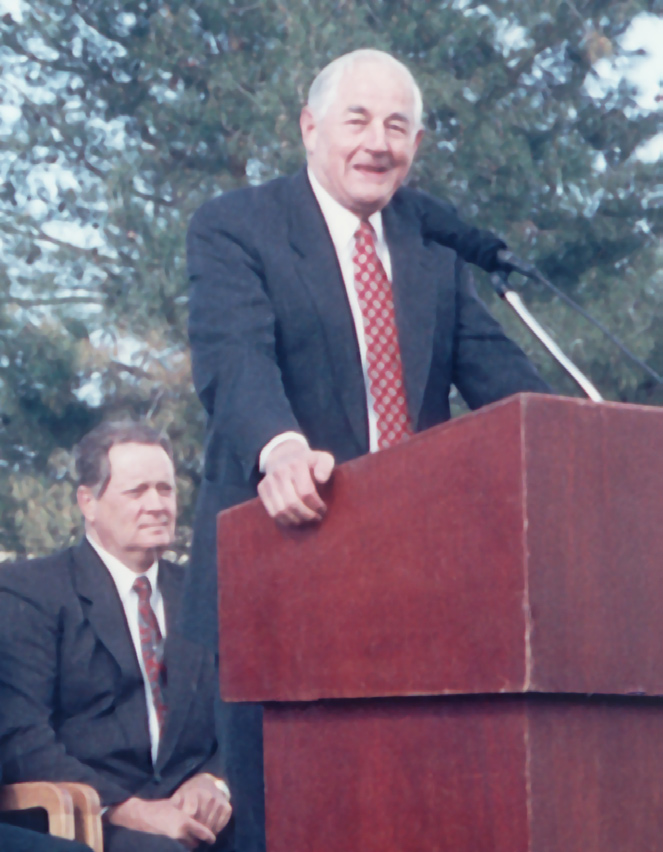 Elder Eran A. Call addresses the large congregation assembled for the temple’s groundbreaking.
Elder Eran A. Call addresses the large congregation assembled for the temple’s groundbreaking.
The culminating moment of the groundbreaking ceremony occurred when Elder Call arose to speak and give the dedicatory prayer. “The wind was blowing and water was dripping off my coat,” Elder Call reported. Because water was running off the pulpit, “I was forced to leave my printed remarks in my pocket.” Still, “I did not feel the cold,” he later reflected. “For my part, I was just thrilled to be [there] for the groundbreaking and to realize that we would have a temple in the colonies.”[15]
Elder Call spoke of the importance the colonies had in Church history. He mentioned the many hardships the settlers endured to establish the colonies. He said that the colonists instigated a spirit of Church service that had grown and provided a great number of leaders in Spanish-speaking areas throughout the world. “This seems to be a culmination of the Lord’s blessing on the colonies. The groundbreaking will start the construction of a beautiful temple on this beautiful site.” Elder Call continued by encouraging members to attend the temple frequently after its dedication. As this was one of the first three small temples, a model temple, he exhorted, “Let this temple be a model of frequent use.”[16]
The incessant winds and biting cold which had persisted up to that point quieted as Elder Call concluded his remarks. As he was about to offer the dedicatory prayer, the clouds parted to let in the warmth of the sun. It seemed like a completely different day. Even those who were still within the shelter of their cars could see a brilliant rainbow in the northern sky—a fitting symbol of God’s awareness of the important event then taking place. Silence fell as Elder Call began his prayer. No one in the crowd wanted to utter a sound that might detract from the special moment.
In his prayer, Elder Call dedicated “this land that Thy prophet, Thy servant, has chosen for the building of Thy house . . . as a holy place, a chosen place where Thy Spirit will dwell.” He petitioned a blessing upon those who would build the temple, “that it may be done in Thy way.” He also asked the Lord to bless the Saints in the temple area, especially those who “have been endowed with knowledge and with sacred covenants, which we have made in holy places, that we may be faithful and obedient to the covenants that we have made, so that some day, Holy Father, Thou might welcome us into Thy holy presence.”[17]
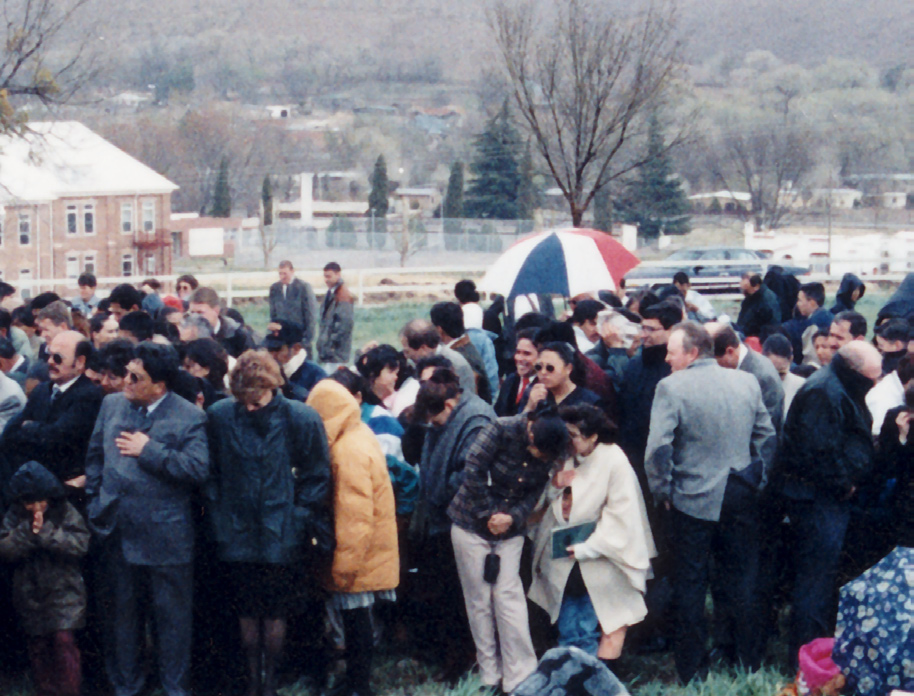 Crowds gathered in stormy weather (above) for the groundbreaking, but the sun broke through (below) as President Eran Call was about to offer the prayer dedicating the site.
Crowds gathered in stormy weather (above) for the groundbreaking, but the sun broke through (below) as President Eran Call was about to offer the prayer dedicating the site.
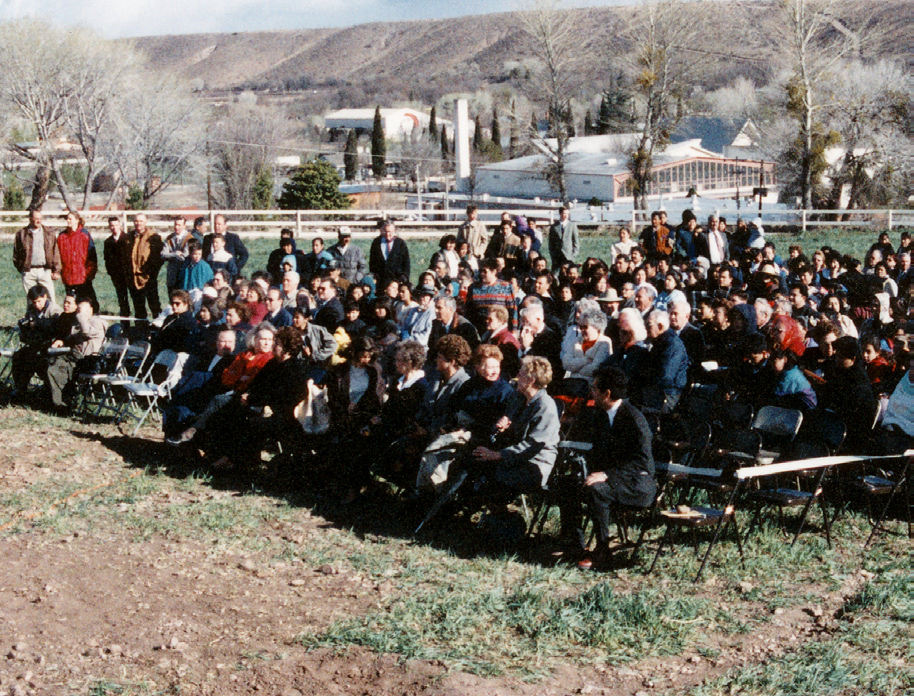
Immediately following the dedicatory prayer and after Elder Call took his seat, the clouds came together once again, and the snow began to fall. But spirits were filled with a warmth that was magnificently expressed by the words of the closing hymn, “El Espíritu de Dios” (The Spirit of God). The Spirit of God like a fire was burning.
Following this hymn, members of the Area Presidency officially broke ground for the Colonia Juárez Chihuahua Temple. Looking back on this, President Cluff reflected, “I couldn’t think of a more wonderful thing to happen to those wonderful people who have so blessed my life. At the groundbreaking ceremony, the thought wouldn’t leave that my parents were there along with many of the pioneers of the colonies. I felt such excitement, happiness, and joy to be privileged to be present that day.”[18]
Notes
[1] Gordon B. Hinckley, in Conference Report, October 1997, 69.
[2] “Construiran templo mormón en esta zona,” El Diario de Nuevo Casas Grandes, November 7, 1997, 1.
[3] Virginia Romney, History of the Colonia Juárez Chihuahua Temple, 1:79; manuscript in authors’ possession.
[4] Hinckley, in Conference Report, October 1997, 69.
[5] Rodmar Pulley, in Romney, History, 1:79.
[6] Meredith Romney, in Romney, History, 1:80.
[7] Meredith Romney, in Romney, History, 1:80–81.
[8] Pulley, in Romney, History, 1:79.
[9] Victor Cerda, in Romney, History, 1:80.
[10] Eran Call interview, February 25, 1999, in Romney, History, 2:263.
[11] “Groundbreaking Ceremony,” in Romney, History, 1:98–99. This section was written by Debra Spilsbury; see also “Temple Started for Mexico Colonies,” Church News, March 14, 1998, 3, 5.
[12] Andrew Larsen to Samuel Cluff, March 7, 1998, in Romney, History, 1:100.
[13] Brenton Yorgason, Two Fond Hearts: The Eran A. and Katherine G. Call Story (Provo, UT: Lighthouse Publishers, 2006), 326–27.
[14] Eran Call, written comments, in Richard Cowan’s possession.
[15] Call interview, in Romney, History, 2:263.
[16] Translated from “Ceremonia de La Primera Palada, Templo Colonia Juárez,” in Romney, History, 1:95–96; for the complete text of Elder Call’s remarks, see appendix D.
[17] Translated from “Oración Dedicatoria del Terreno,” in Romney, History, 1:97; for the complete text of the site dedicatory prayer, see appendix D.
[18] Samuel Cluff, in Romney, History, 1:74.
